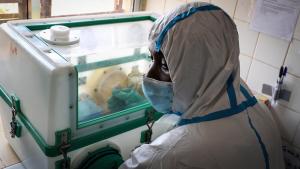Leaving a legacy after Ebola in Guinea
N’zerekore – It is a quiet morning at an Ebola treatment centre in the outskirts of N’zerekore, a town in the south-east of Guinea. The centre’s triage and reception areas are all empty, and medical staff are relaxed and jovial as they tend to a small handful of patients or catch up on some administrative tasks in the office.
Just weeks ago, these same staff members were on the frontlines of the fight against an Ebola epidemic that had spread through this forested south-eastern region of Guinea. The outbreak ‘s first case was detected on 14 February 2021, and 23 cases and 12 deaths were subsequently recorded. Many of them were treated at the centre outside N’Zerekore.
Due to the swift response of Guinean health authorities, with support from the World Health Organization (WHO), the epidemic was declared over on 19 June. But even as a welcome calm has since descended at the treatment centre, the support of WHO and partners will continue to live on. “With all the support and training we received from the Organization, we will be better equipped to deal with future epidemics,” says Pauline Guilavogui, a health promoter at the centre, as she goes about her morning rounds.
“During an epidemic, we try to put everything in place not only to break the chain of transmission of the disease, but to give all the necessary tools to health personnel as well as to the community to be able to respond locally themselves to any other emergency,” says Beinvenu Houndjo, who leads the Infection Prevention and Control (IPC) programme for WHO Guinea, and who has been on the ground in N’zerekore since the beginning of the recent outbreak. “One of the strategies is to develop the competence of local health workers and entrench a strong IPC culture for the future.”
In addition to diverse trainings and consistent technical support, WHO has also helped to fund and implement a range of infrastructure and provide equipment that can be easily repurposed towards other health emergencies. Among other things, at the provincial health department in the centre of N’zerekore, the Organization has equipped a state-of-the-art conference room and set up a call centre and hotline for reporting suspected Ebola cases. At the Ebola treatment centre in N’Zerekore, WHO has helped to finance the construction of biosecure emergency care units. It has also provided 30 motorbikes and a 4x4 vehicle to local health authorities to assist with on-the-ground case surveillance in N’zerekore and surrounding towns and villages.
“An epidemic is never planned, but if you have structures and equipment that are well established and that are functional, these can also serve to manage cases for many other diseases,” says Dr Marie Claire Lamah, WHO Guinea case management administrator, who provided technical support to staff at the treatment centre throughout the Ebola outbreak.
Her point is clearly illustrated by the enduring value of the expertise, infrastructure and general public health awareness gained through the previous Ebola outbreak in the region, which claimed over 11 000 lives in Sierra Leone, Liberia and Guinea between 2014 and 2016. This has already played an important role in the ongoing response to COVID-19 pandemic. Along with a strong vaccination drive and improved therapeutics, it has also contributed to the much swifter suppression of the most recent Ebola epidemics in both Guinea and the Democratic Republic of Congo.
In the laboratory at N’zerekore’s central hospital, a couple of technicians carefully handle COVID-19 polymerase chain reaction test samples taken that morning. They are dressed from head to toe in personal protective equipment provided by WHO; the Organization has also provided the small lab with a fridge and a GeneExpert diagnostic testing machine that can be used for both COVID-19 and tuberculosis. Throughout the Ebola epidemic, the lab also received consistent training and technical support from WHO lab and IPC experts.
“WHO’s support has been very useful,” says Dr Youssouf Sidibé, the laboratory supervisor, as he watches the technicians at work. “They have improved the technical capacity of our laboratory and this will continue to be beneficial going forward, whether for COVID or otherwise. We very much hope we will have a lasting relationship with the Organization.”



